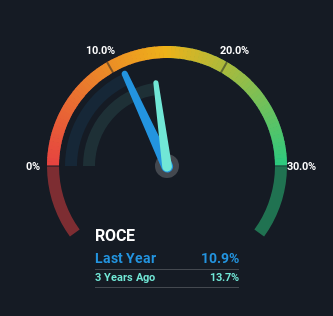
What are the early trends we should look for to identify a stock that could multiply in value over the long term? Firstly, we'd want to identify a growing return on capital employed (ROCE) and then alongside that, an ever-increasing base of capital employed. Ultimately, this demonstrates that it's a business that is reinvesting profits at increasing rates of return. However, after investigating Pekabex (WSE:PBX), we don't think it's current trends fit the mold of a multi-bagger.
Return On Capital Employed (ROCE): What Is It?
For those that aren't sure what ROCE is, it measures the amount of pre-tax profits a company can generate from the capital employed in its business. To calculate this metric for Pekabex, this is the formula:
Return on Capital Employed = Earnings Before Interest and Tax (EBIT) ÷ (Total Assets - Current Liabilities)
0.11 = zł82m ÷ (zł1.5b - zł781m) (Based on the trailing twelve months to March 2024).
Therefore, Pekabex has an ROCE of 11%. In isolation, that's a pretty standard return but against the Construction industry average of 15%, it's not as good.
View our latest analysis for Pekabex

In the above chart we have measured Pekabex's prior ROCE against its prior performance, but the future is arguably more important. If you'd like, you can check out the forecasts from the analysts covering Pekabex for free.
What Does the ROCE Trend For Pekabex Tell Us?
In terms of Pekabex's historical ROCE movements, the trend isn't fantastic. Over the last five years, returns on capital have decreased to 11% from 17% five years ago. However it looks like Pekabex might be reinvesting for long term growth because while capital employed has increased, the company's sales haven't changed much in the last 12 months. It may take some time before the company starts to see any change in earnings from these investments.
On a side note, Pekabex's current liabilities have increased over the last five years to 51% of total assets, effectively distorting the ROCE to some degree. Without this increase, it's likely that ROCE would be even lower than 11%. And with current liabilities at these levels, suppliers or short-term creditors are effectively funding a large part of the business, which can introduce some risks.
What We Can Learn From Pekabex's ROCE
In summary, Pekabex is reinvesting funds back into the business for growth but unfortunately it looks like sales haven't increased much just yet. Investors must think there's better things to come because the stock has knocked it out of the park, delivering a 181% gain to shareholders who have held over the last five years. However, unless these underlying trends turn more positive, we wouldn't get our hopes up too high.
If you're still interested in Pekabex it's worth checking out our FREE intrinsic value approximation for PBX to see if it's trading at an attractive price in other respects.
While Pekabex isn't earning the highest return, check out this free list of companies that are earning high returns on equity with solid balance sheets.
New: Manage All Your Stock Portfolios in One Place
We've created the ultimate portfolio companion for stock investors, and it's free.
• Connect an unlimited number of Portfolios and see your total in one currency
• Be alerted to new Warning Signs or Risks via email or mobile
• Track the Fair Value of your stocks
Have feedback on this article? Concerned about the content? Get in touch with us directly. Alternatively, email editorial-team (at) simplywallst.com.
This article by Simply Wall St is general in nature. We provide commentary based on historical data and analyst forecasts only using an unbiased methodology and our articles are not intended to be financial advice. It does not constitute a recommendation to buy or sell any stock, and does not take account of your objectives, or your financial situation. We aim to bring you long-term focused analysis driven by fundamental data. Note that our analysis may not factor in the latest price-sensitive company announcements or qualitative material. Simply Wall St has no position in any stocks mentioned.
About WSE:PBX
Pekabex
A construction company, engages in the production and sale of prefabricated reinforced and pre-stressed concrete elements in Poland, Sweden, Denmark, Germany, Switzerland, Hungary, and internationally.
Questionable track record with imperfect balance sheet.
Market Insights
Community Narratives



